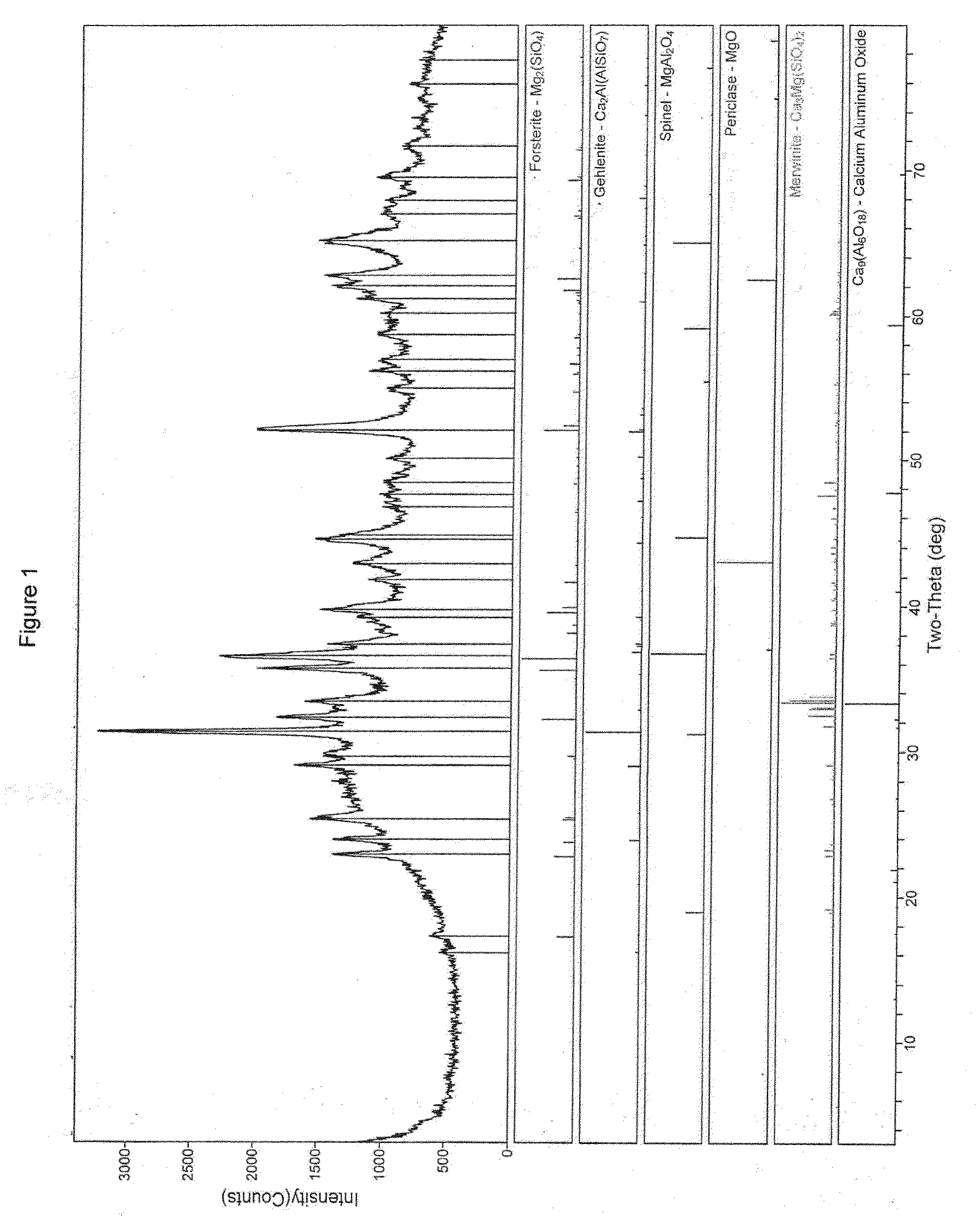Heavy Metals Trapping Co-Catalyst For FCC Processes
a heavy metals and cocatalyst technology, applied in the direction of catalyst activation/preparation, metal/metal-oxide/metal-hydroxide catalyst, physical/chemical process catalyst, etc., can solve the problems of increasing asphaltic content, affecting the quality of asphaltic products, etc., to achieve excellent shelf life, reduce the reaction of magnesium, and high solid content
- Summary
- Abstract
- Description
- Claims
- Application Information
AI Technical Summary
Benefits of technology
Problems solved by technology
Method used
Image
Examples
example 1
[0053]A metal trap, according to this invention, was prepared by mixing a magnesium oxide slurry with slurries of calcium carbonate and kaolin as follows:
[0054]A magnesium oxide slurry was prepared at 20-22% solids and was added in a reslurry operation to the desired analytical content.
[0055]A commercial calcium carbonate slurry at 75% (Hydrocarb 60) sold by Omya North America, Procter, Vt., which is a ground calcium carbonate was used.
[0056]The kaolin slurry was prepared at 55% solids .
[0057]The three slurries were mixed at existing solids using a reslurry system similar to a Cowles or other suitable high shear device. The Magnesium Oxide and water were added to achieve total solids >40% up to 50%. The samples were prepared to contain approximately 15% calcium and magnesium by weight and 70% kaolin when dehydroxylated. The purpose of the experiment was to determine the relationship of calcination temperature, physical properties, and zeolite retention when varying calcination condi...
example 2
[0075]Samples 1-4 were prepared by blending the calcium carbonate into the kaolin or kaolin mixture and then adding the magnesium hydroxide. Slurry solids are maintained at 50% solids by weight or higher.
1. Control
[0076]a. Mg(OH)2—5.8 dry pounds[0077]b. Kaolin—18.6 dry pounds[0078]c. 10.0 pounds of calcium carbonate.[0079]a. Mg(OH)2—5.8 dry pounds[0080]b. Kaolin—15.8 dry pounds[0081]c. Ansilex 93®-2.4 dry pounds[0082]d. 10.0 pounds of calcium carbonate[0083]1. Ansilex is a fine fully calcined kaolin.[0084]a. Mg(OH)2—5.8 dry pounds[0085]b. Kaolin—13.0 dry pounds[0086]c. Ansilex 93-4.8 dry pounds[0087]d. 10.0 pounds of calcium carbonate.[0088]a. Mg(OH)2—5.8 dry pounds[0089]b. Kaolin—10.3 dry pounds[0090]c. Ansilex 93-7.2 dry pounds[0091]d. 10.0 pounds of calcium carbonate.
Sample 1Sample 2Sample 3Sample 4Calcination Temp.1650 F.1750 F.1650 F.1750 F.1650 F.1750 F.1650 F.1750 F.Average Particle72.3073.1280.3779.9276.7174.8682.3181.60Size (microns)% less105 m84.3489.9880.0678.6283.3284.07...
example 3
[0092]A stability study was conducted on the following: all samples were mixed in a pilot plant scale Cowles mixer.
SolidspHBFKaolin59.55%9.8Hydrocarb 9076.68%9.2425AquaMag1 - Magnesium Hydroxide55.19%11.317401Manufactured by OmyaBlend 1500 dry gramsorderratiodry wt.(g)wet wt.(g)1 AquaMag23.0%345625.12 Hyd 9024.0%360469.53 Kaolin53.0%7951335.0BrookfieldViscosity (cps)SolidspHInitial80054.95%10.34 hours156055.30%↓At 4 hours, was added to a portion of sample (2.0% 3.22 modulus sodiumsilicate)BrookfieldViscosity (cps)Solidsinitial3555.30%24 hours3555.89%48 hours3556.64%24 hours510056.30%48 hours16,00057.80%↓At 48 hours .5% silicate was added to a portion of the sample 306 drygrams × 0.5% = 1.53 gms (3.22 modulus sodium slicate)BrookfieldViscosity (cps)SolidspHInitial5057.80%24 hours16559.61%11.35Blend 750 dry grams1 AquaMag23.0%2 Hyd 9024.0%3 Kaolin53.0%1. Added 0.5% 3.22 sodium silicate to kaolin, based on total dry grams ofblend 750 × 0.5% = 3.75 gms 3.22 sodium silicate2. Blended Aqu...
PUM
| Property | Measurement | Unit |
|---|---|---|
| temperature | aaaaa | aaaaa |
| temperature | aaaaa | aaaaa |
| particle size | aaaaa | aaaaa |
Abstract
Description
Claims
Application Information
 Login to View More
Login to View More - R&D
- Intellectual Property
- Life Sciences
- Materials
- Tech Scout
- Unparalleled Data Quality
- Higher Quality Content
- 60% Fewer Hallucinations
Browse by: Latest US Patents, China's latest patents, Technical Efficacy Thesaurus, Application Domain, Technology Topic, Popular Technical Reports.
© 2025 PatSnap. All rights reserved.Legal|Privacy policy|Modern Slavery Act Transparency Statement|Sitemap|About US| Contact US: help@patsnap.com

